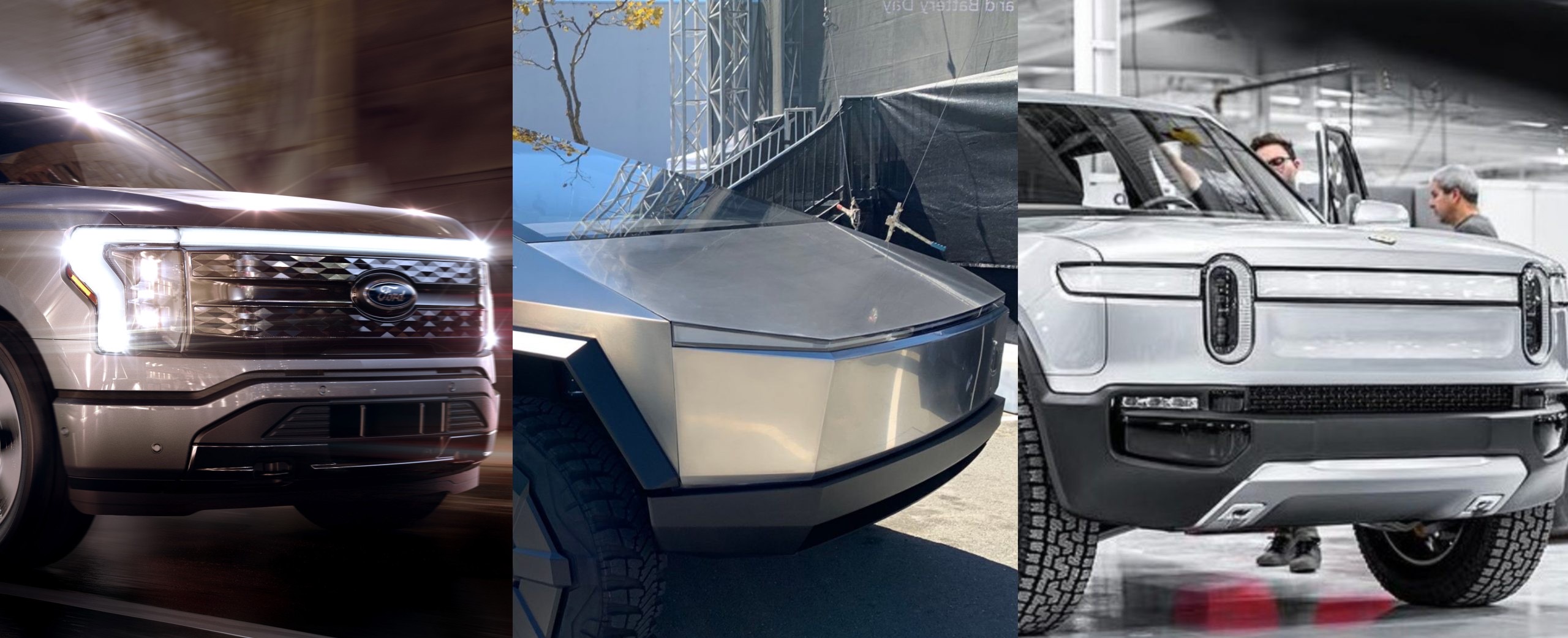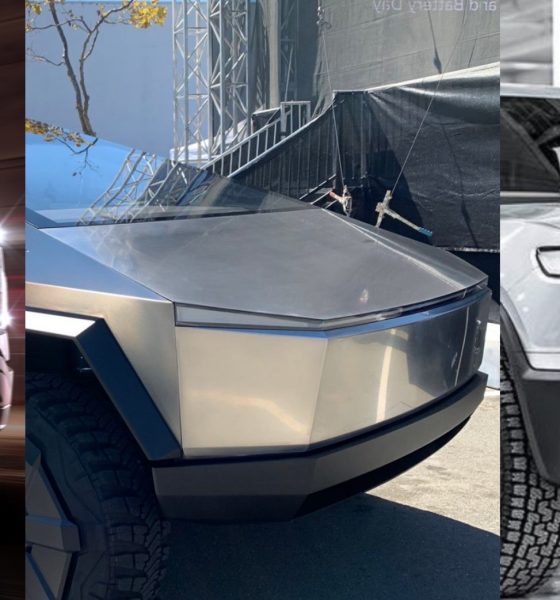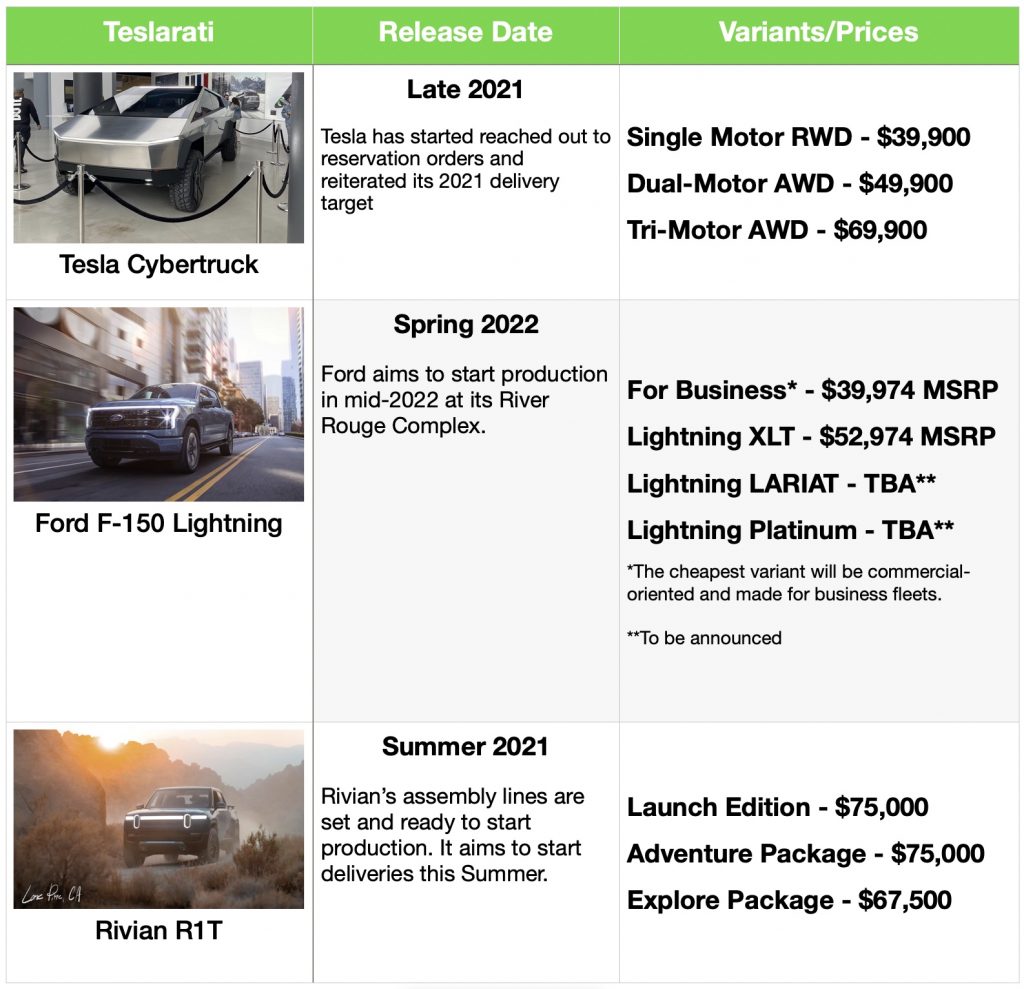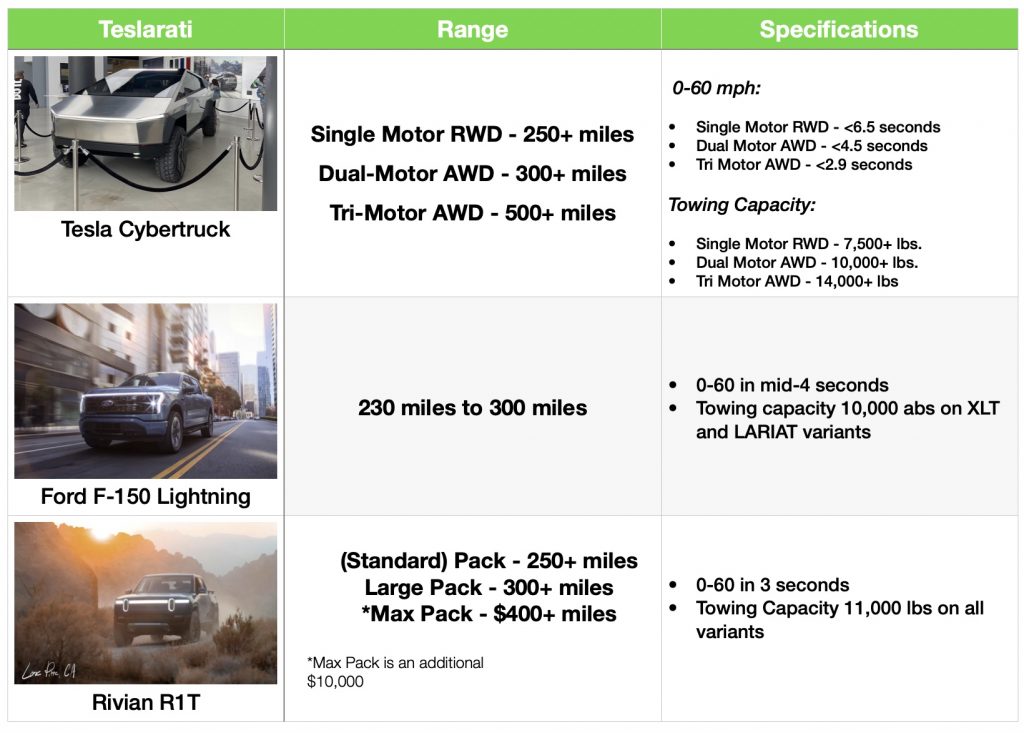

News
F-150 Lightning vs Tesla Cybertruck vs Rivian R1T: How Ford’s new EV stacks up against younger competitors
Ford recently unveiled the F-150 Lightning, marking the entry of another legacy automaker into the all-electric pickup truck market. The Ford F-150 is an iconic pickup truck, and its transition to the electric vehicle spectrum is a big step for American auto manufacturing.
However, as the Ford F-150 enters a new playing field, the OEM will be met with new contenders from startup EV makers such as Rivian and Tesla. While the Ford F-150 has been the standard for pickup trucks, Tesla has made a name for itself in the EV space. Rivian seeks to forge its own path in the EV market by delivering the first all-electric pickup truck to customers as well.

Rivian aims to start deliveries of the R1T Launch Edition in June 2021. As such, the Rivian R1T will be the first all-electric pickup truck to hit the market. Rivian told Teslarati that it has started contacting reservation holders in preparation for deliveries. Along with the start of deliveries, Rivian plans to launch a 4-month Demonstration Drive program across the United States to help new owners navigate their R1T pickup trucks.
The Tesla Cybertruck will be produced in Gigafactory Texas, which has been progressing rather quickly. Tesla has also started reaching out to Cybertruck reservation holders and reiterating its late 2021 delivery goal for the Tri-Motor AWD and Dual-Motor AWD variants.
Ford still has about a year to go before producing the all-electric F-150 Lightning at its Rouge plant. The legacy automaker plans to produce four variants of the F-150 Lightning, including one specifically produced and priced for business owners. Ford has not listed the price of the Lariat or Platinum yet. However, it did state that the Lightning’s MSRP starts at $39,974 and goes up to $90,474.

When it comes to function and utility, each of the electric pickup trucks has its advantages. For instance, Rivian made the R1T for owners who seek adventures outdoors. To accommodate future R1T explorers, Rivian has included certain features like the Gear Tunnel for muddy or wet items and an air compressor with a maximum pressure of 150 psi for tires or inflatable items.
On the other hand, the Ford F-150 Lightning seems geared more towards business owners. Ford seems to know its customer base very well as it added certain details to the F-150 Lightning that would be useful on the job site, like enhanced zone lighting and a slew of power outlets both front and back.
In a unique twist, the OEM also built the F-150 Lightning with Ford Intelligent backup power, allowing the vehicle to off-board up to 9.6 kW of peak energy. Ford estimates that the F-150 Lightning can power an entire home for three days or up to ten days if the power is rationed. Its estimates are based on home usage of 30 kWh per day using the F-150 Lightning’s extended battery.
The Tesla Cybertruck seems to tread the middle ground compared to the Rivian R1T and the Ford F-150 Lightning. Each Cybertruck variant could meet the need of explorers or business owners. Tesla also has its unique software system for Cybertruck owners, which has become an ecosystem of its own with features like Camp Mode, Dog Mode, Sentry Mode, and Tesla Theater, among others.
The Teslarati team would appreciate hearing from you. If you have any tips, email us at tips@teslarati.com or reach out to me at maria@teslarati.com.

News
Elon Musk’s Grok AI to be used in U.S. War Department’s bespoke AI platform
The partnership aims to provide advanced capabilities to 3 million military and civilian personnel.

The U.S. Department of War announced Monday an agreement with Elon Musk’s xAI to embed the company’s frontier artificial intelligence systems, powered by the Grok family of models, into the department’s bespoke AI platform GenAI.mil.
The partnership aims to provide advanced capabilities to 3 million military and civilian personnel, with initial deployment targeted for early 2026 at Impact Level 5 (IL5) for secure handling of Controlled Unclassified Information.
xAI Integration
As noted by the War Department’s press release, GenAI.mil, its bespoke AI platform, will gain xAI for the Government’s suite of tools, which enable real-time global insights from the X platform for “decisive information advantage.” The rollout builds on xAI’s July launch of products for U.S. government customers, including federal, state, local, and national security use cases.
“Targeted for initial deployment in early 2026, this integration will allow all military and civilian personnel to use xAI’s capabilities at Impact Level 5 (IL5), enabling the secure handling of Controlled Unclassified Information (CUI) in daily workflows. Users will also gain access to real‑time global insights from the X platform, providing War Department personnel with a decisive information advantage,” the Department of War wrote in a press release.
Strategic advantages
The deal marks another step in the Department of War’s efforts to use cutting-edge AI in its operations. xAI, for its part, highlighted that its tools can support administrative tasks at the federal, state and local levels, as well as “critical mission use cases” at the front line of military operations.
“The War Department will continue scaling an AI ecosystem built for speed, security, and decision superiority. Newly IL5-certified capabilities will empower every aspect of the Department’s workforce, turning AI into a daily operational asset. This announcement marks another milestone in America’s AI revolution, and the War Department is driving that momentum forward,” the War Department noted.
News
Tesla FSD (Supervised) v14.2.2 starts rolling out
The update focuses on smoother real-world performance, better obstacle awareness, and precise end-of-trip routing, among other improvements.

Tesla has started rolling out Full Self-Driving (Supervised) v14.2.2, bringing further refinements to its most advanced driver-assist system. The new FSD update focuses on smoother real-world performance, better obstacle awareness, and precise end-of-trip routing, among other improvements.
Key FSD v14.2.2 improvements
As noted by Not a Tesla App, FSD v14.2.2 upgrades the vision encoder neural network with higher resolution features, enhancing detection of emergency vehicles, road obstacles, and human gestures. New Arrival Options let users select preferred drop-off styles, such as Parking Lot, Street, Driveway, Parking Garage, or Curbside, with the navigation pin automatically adjusting to the user’s ideal spot for precision.
Other additions include pulling over for emergency vehicles, real-time vision-based detours for blocked roads, improved gate and debris handling, and extreme Speed Profiles for customized driving styles. Reliability gains cover fault recovery, residue alerts on the windshield, and automatic narrow-field camera washing for new 2026 Model Y units.
FSD v14.2.2 also boosts unprotected turns, lane changes, cut-ins, and school bus scenarios, among other things. Tesla also noted that users’ FSD statistics will be saved under Controls > Autopilot, which should help drivers easily view how much they are using FSD in their daily drives.
Key FSD v14.2.2 release notes
Full Self-Driving (Supervised) v14.2.2 includes:
- Upgraded the neural network vision encoder, leveraging higher resolution features to further improve scenarios like handling emergency vehicles, obstacles on the road, and human gestures.
- Added Arrival Options for you to select where FSD should park: in a Parking Lot, on the Street, in a Driveway, in a Parking Garage, or at the Curbside.
- Added handling to pull over or yield for emergency vehicles (e.g. police cars, fire trucks, ambulances).
- Added navigation and routing into the vision-based neural network for real-time handling of blocked roads and detours.
- Added additional Speed Profile to further customize driving style preference.
- Improved handling for static and dynamic gates.
- Improved offsetting for road debris (e.g. tires, tree branches, boxes).
- Improve handling of several scenarios, including unprotected turns, lane changes, vehicle cut-ins, and school buses.
- Improved FSD’s ability to manage system faults and recover smoothly from degraded operation for enhanced reliability.
- Added alerting for residue build-up on interior windshield that may impact front camera visibility. If affected, visit Service for cleaning!
- Added automatic narrow field washing to provide rapid and efficient front camera self-cleaning, and optimize aerodynamics wash at higher vehicle speed.
- Camera visibility can lead to increased attention monitoring sensitivity.
Upcoming Improvements:
- Overall smoothness and sentience.
- Parking spot selection and parking quality.
News
Tesla is not sparing any expense in ensuring the Cybercab is safe
Images shared by the longtime watcher showed 16 Cybercab prototypes parked near Giga Texas’ dedicated crash test facility.

The Tesla Cybercab could very well be the safest taxi on the road when it is released and deployed for public use. This was, at least, hinted at by the intensive safety tests that Tesla seems to be putting the autonomous two-seater through at its Giga Texas crash test facility.
Intensive crash tests
As per recent images from longtime Giga Texas watcher and drone operator Joe Tegtmeyer, Tesla seems to be very busy crash testing Cybercab units. Images shared by the longtime watcher showed 16 Cybercab prototypes parked near Giga Texas’ dedicated crash test facility just before the holidays.
Tegtmeyer’s aerial photos showed the prototypes clustered outside the factory’s testing building. Some uncovered Cybercabs showed notable damage and one even had its airbags engaged. With Cybercab production expected to start in about 130 days, it appears that Tesla is very busy ensuring that its autonomous two-seater ends up becoming the safest taxi on public roads.
Prioritizing safety
With no human driver controls, the Cybercab demands exceptional active and passive safety systems to protect occupants in any scenario. Considering Tesla’s reputation, it is then understandable that the company seems to be sparing no expense in ensuring that the Cybercab is as safe as possible.
Tesla’s focus on safety was recently highlighted when the Cybertruck achieved a Top Safety Pick+ rating from the Insurance Institute for Highway Safety (IIHS). This was a notable victory for the Cybertruck as critics have long claimed that the vehicle will be one of, if not the, most unsafe truck on the road due to its appearance. The vehicle’s Top Safety Pick+ rating, if any, simply proved that Tesla never neglects to make its cars as safe as possible, and that definitely includes the Cybercab.








